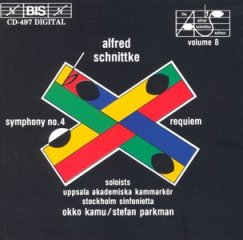Alfred Schnittke - Symphony No 4 – Requiem (1993)
Alfred Schnittke - Symphony No 4 – Requiem (1993)

01. Sympony No 4 (41:38)
02. Requiem - Requiem (3:33) play
03. Requiem - Kyrie (2:01)
04. Requiem - Dies Irae (1:13)
05. Requiem - Tuba Mirum (3:52)
06. Requiem - Rex Tremenda (1:16)
07. Requiem - Recordare (2:34)
08. Requiem - Lacrimosa (2:35)
09. Requiem - Domie Jesu (1:28)
10. Requiem - Hostias (1:13)
11. Requiem - Sanctus (3:45) play
12. Requiem - Benedictus (2:05)
13. Requiem - Agnus Dei (2:27)
14. Requiem - Credo (3:57)
15. Requiem - Requiem (2) (4:01)
Stockholm Sinfonnietta
Stefan Parkman – conductor
Russian composer Alfred Schnittke wrote his Symphony No. 4 in 1983. It is a choral symphony, written for tenor, countertenor, chorus, and orchestra. It was first performed on April 12, 1984, in Moscow. The symphony is written in a single movement of 22 variations and is approximately 45 minutes in length. The form of Schnittke's Fourth Symphony is at once cross-shaped and spherical. The composer draws musically on the three main strands of Christianity—Orthodox, Catholic, Protestant—while underlying this is a three–note semitone interval motif representing synagogue chant, thus symbolizing the Jewish source of Christianity." The result, Ivan Moody writes, is that Schnittke "attempts to reconcile elements of znamennïy and Gregorian chant, the Lutheran chorale and Synagogue cantillation ... within a dense, polyphonic orchestral texture" A tenor and a countertenor also sing wordlessly at two points in the symphony. Words are saved for a finale in which all four types of church music are used contrapuntally as a four-part choir sings the Ave Maria. The choir can choose whether to sing the Ave Maria in Russian or Latin. The programmatic intent of using these different types of music, Schnittke biographer Alexander Ivashkin writes, is an insistence by the composer "on the idea ... of the unity of humanity, a synthesis and harmony among various manifestations of belief."
The Requiem (1974 - 1975) takes as its starting points the choral Russian funeral service for the dead and the bells and gongs of Stravinsky's recently completed Requiem Canticles (1965 - 1966). Composed after the piano quintet that had been dedicated to the composer's mother, Schnittke's Requiem was originally intended to be part of the incidental music for Schiller's Don Carlos. However, the scale and scope of the work effectively forced its removal from the incidental music and Schnittke re-imagined it as a separate concert work. Schnittke's setting conforms to the usual order of the Latin mass for the dead, but with the addition of a Credo as the penultimate movement and with a repetition of the opening Requiem text in place of the Lux Aeternum. A pros pro on the emotional content of the work, Schnittke remarked that "there is an escalating desire for expression which gives the work the character of a powerful confession." In order that this expression may be understood, Schnittke employs a fundamentally tonal language with roots deep in Russian chant. Scored for soloists and chorus, the work's instrumental accompaniment consists of only brass, piano, organ, and a vast array of percussion instruments including a drum kit in the work's climax. The Requiem is in 14 movements. –BIS Records
download: uploaded yandex 4shared divshare mediafire solidfiles mega zalivalka filecloudio anonfiles oboom
Zmieniony (Czwartek, 24 Kwiecień 2014 20:03)








